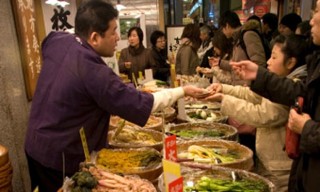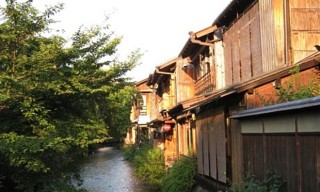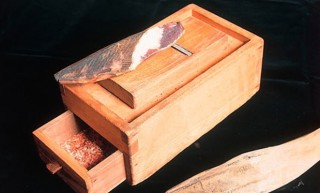Loading
Search
▼ Raw Passion in Japan: Charlie Brooker's Home Cookery Lesson
- Category:Tourism

THE GUARDIAN
In the Guardian and Observer Readers' Travel Awards 2012, Japan was your favourite long-haul destination. There, in historic Kyoto, Charlie Brooker takes a Japanese cookery lesson in a rare visit to a Japanese home.
Like most wimps, I have a thing about best-before dates. I know they're a con; I know groceries last about 100 years longer than supermarkets pretend they do. I know throwing perfectly edible food away is an obscenity – doubly so if it's part of an animal that was butchered for your convenience. I know that. But it's still hard for me to ingest anything I even vaguely suspect might be "on the turn".
Imagine my surprise, then, to find myself cheerfully shaving bits off a six-month-old chunk of desiccated tuna in order to make soup.
Nevertheless, that's what happened to me in Kyoto.
If you ever visit Japan, make room for a few days in Kyoto if at all possible. Tokyo can feel like a gigantic over-stimulating pachinko machine if you don't stick your head out for air now and then. Another advantage is that you can take the bullet train.

Given its nickname, I'd expected my journey on the high-speed Tokyo-Kyoto Shinkansen service to feel like some kind of terrifying vertical freefall; to be pinned to my seat by the G-force, my cheeks shearing backwards and flapping behind me like the ears of a basset hound fired from a cannon. The reality is almost underwhelmingly sedate. The train is as quiet as it is fast – so there's no rickety clatter – and for the majority of the journey the track is raised above ground level, which means you don't see trees whipping past the window, increasing the illusion of speed. What I'm saying is a Virgin Train to Birmingham New Street actually packs more of a thrill. Where the Shinkansen wins is on sheer gliding efficiency. It's like travelling on Valium, and I mean that in a good way.
Once you're clear of the boxy downtown area, Kyoto coughs up picture-postcard back streets and around 2,000 ancient shrines and temples: the cherry-blossom Japan of your imagination. But I hadn't come just for the sights. I was here for a cookery lesson. This is a tourist "experience" offered by the Women's Association of Kyoto: the lessons take place in the real homes of real housewives with real arms and legs and everything, in real Japan. The Japanese rarely invite strangers into their homes. In fact, they rarely invite anyone into their homes – it's an honour chiefly reserved for close friends. What, exactly, are they hiding? We were going to find out.

First we had to shop for ingredients. This meant a guided tour of Nishiki market, a narrow covered parade of stalls and shops selling fresh produce and local delicacies, the majority of which are visually incomprehensible to the untrained western eye. And by "untrained western eye", I mean me. I didn't have a clue what I was looking at, but almost everything seemed to fall into one of two categories: mouth-watering or menacing. There were baffling vegetables that looked like the kind of thing Captain James T Kirk might negotiate with over a long-range scanner. There were pickled objects of unfathomable origin. There were mahogany-brown smoked eggs. And there was katsuobushi, which is the only thing I've mentioned so far that you may well have already eaten, probably without having the faintest idea what it actually is.
It won't help if I explain that katsuobushi looks and feels like a piece of ancient water-worn timber, like a chunk of Tudor warship slowly rendered pebble-smooth by centuries of undersea friction. But it isn't. It's a fish.
Specifically, it's a skipjack tuna that has been filleted, smoked for the best part of a month, placed in a humid environment until it develops a fine layer of mould, taken out and dried, put back in the humidifier for more mould-growing, dried again, re-humidified, and so on, until eventually it's declared ready. In summary: it's a dry, mouldy fish that has been sitting around for months. And like I say, you've probably eaten it – in some form – if you've ever had miso soup. Because when you grate katsuobushi, the resultant shavings are known as bonito flakes, which – bursting with distinctive umami flavour – are one of the primary ingredients in the stock that forms the bulk of every bowl of miso soup you've ever slurped. Most miso soup is made with instant dashi these days, but still: desiccated mould-encrusted tuna. That's the source. Sorry to break that to you. Especially if you're a vegetarian.

On the plus side, bonito flakes smell delicious, as I discovered during the eventual cookery lesson, in a small house on the outskirts of Kyoto. And what was the mysterious forbidden interior of a Japanese home like?
Tatami flooring? Low tables? Fragile origami furniture? No. Nothing to hide. In fact it seemed virtually identical to a British home. Our friendly hostess, Kiyoko Obase, even had an apron with the London tube map on it and a newspaper article about The King's Speech pinned to the fridge.
And it was raining outside, thereby completing the impression that we could have been in Dudley. The scent of the food we made was the giveaway.
As well as fresh miso soup, we made rolled sushi, with a side dish of horenso no goma-ae (that's spinach with sesame dressing to you). I ate a lot of unfamiliar things in Japan – raw prawns, raw chicken, raw God-knows-what – but in a way this meal was the most startling. Despite being straightforward stuff – the most complex element, the rolled sushi, was surprisingly simple to make – it was powerfully satisfying, partly due to the glow of DIY achievement, but also because it was the first time Japanese food struck me as comfort food. And as home cooking, to be prepared and eaten at home. Albeit someone else's home. On the other side of the planet.
- November 7, 2015
- Comment (0)
- Trackback(0)

